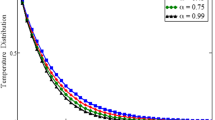Abstract
This paper presents an investigation of the non-periodic boundary condition (NPBC) which is often used in multiscale atomistic–continuum simulations. The relationship between the boundary force exerted by the imaginary atoms outside the atomistic domain and the fluid state parameters including density and temperature at the boundary is studied. A fitting formula of the boundary force as a function of the fluid state has been proposed based on the relationship. The accuracy of the fitting formula is verified by the equilibrium molecular dynamics (MD) simulations. Poiseuille flow with viscous dissipation and unsteady heat transfer between two walls is then simulated using the proposed fitting formula. The elimination of density oscillation near the boundary of atomistic region and good agreement of velocity and temperature evolutions with time from pure MD and the multiscale simulations adopting NPBC further confirm the correctness of our fitting formula.










Similar content being viewed by others
References
Allen MP, Tildesley DJ (1987) Computer simulation of liquids. Clarendon Press, Oxford
Balasubramanian G, Banerjee S, Puri IK (2008) Unsteady nanoscale thermal transport across a solid-fluid interface. J Appl Phys 104:064306
Bamdad M, Alavi S, Najafi B, Keshavarzi E (2006) A new expression for radial distribution function and infinite shear modulus of Lennard-Jones fluids. Chem Phys 325:554–562
Borg MK, Macpherson GB, Reese JM (2010) Controllers for imposing continuum-to-molecular boundary conditions in arbitrary fluid flow geometries. Mol Simulat 36:745–757
Delgado-Buscalioni R, Coveney PV (2003) Continuum-particle hybrid coupling for mass, momentum, and energy transfers in unsteady fluid flow. Phys Rev E 67:046704
Flekkoy EG, Wagner G, Feder J (2000) Hybrid model for combined particle and continuum dynamics. Europhys Lett 52:271–276
He YL, Tao WQ (2012) Multiscale simulations of heat transfer and fluid flow problems. J Heat Transf T ASME 134:031018
Huang ZG, Guo ZN, Yue TM, Chan KC (2010) Non-periodic boundary model with soft transition in molecular dynamics simulation. Europhys Lett 92:50007
Kotsalis EM, Walther JH, Koumoutsakos P (2007) Control of density fluctuations in atomistic–continuum simulations of dense liquids. Phys Rev E 76:016709
Li YX, Xu JL (2006) A new criterion number for the boundary conditions at the solid/liquid interface in nanoscale. Nanosc Microsc Therm 10:109–141
Liu J, Chen SY, Nie XB, Robbins MO (2007) A continuum-atomistic simulation of heat transfer in micro- and nano-flows. J Comput Phys 227:279–291
Maruyama S, Kimura T (1999) A study on thermal resistance over a solid-liquid interface by the molecular dynamics method. Therm Sci Eng 7:63–68
Matteoli E, Ali Mansoori G (1995) A simple expression for radial distribution functions of pure fluids and mixtures. J Chem Phys 103:4672–4677
Mendelev MI, Han S, Srolovitz DJ, Ackland GJ, Sun DY, Asta M (2003) Development of new interatomic potentials appropriate for crystalline and liquid iron. Philos Mag 83:3977–3994
National Institute of Standards and Technology (NIST) (2005) Thermophysical properties of fluid systems. http://webbook.nist.gov/chemistry/fluid/
Nie XB, Chen SY, E WN, Robbins MO (2004) A continuum and molecular dynamics hybrid method for micro- and nano-fluid flow. J Fluid Mech 500:55–64
O’Connell ST, Thompson PA (1995) Molecular dynamics-continuum hybrid computations: a tool for studying complex fluid flows. Phys Rev E 52:R5792
Plimpton SJ (1995) Fast parallel algorithms for short-range molecular dynamics. J Comput Phys 117:1–19
Rapaport DC (2004) The art of molecular dynamics simulation, 2nd edn. Cambridge University Press, Cambridge
Sun J, He YL, Tao WQ (2010) Scale effect on flow and thermal boundaries in micro-/nano-channel flow using molecular dynamics–continuum hybrid simulation method. Int J Numer Meth Eng 81:207–228
Tao WQ (2001) Numerical heat transfer (2nd edn). Xi’an Jiaotong University Press, Xi’an
Tao WQ, He YL (2009) Recent advances in multiscale simulation of heat transfer and fluid flow problems. Prog Comput Fluid Dy 9:150–157
Tully JC (1980) Dynamics of gas-surface interactions: 3D generalized langevin model applied to fcc and bcc surfaces. J Chem Phys 73:1975–1985
Werder T, Walther JH, Koumoutsakos P (2005) Hybrid atomistic–continuum method for the simulation of dense fluid flows. J Comput Phys 205:373–390
Xu JL, Li YX (2007) Boundary conditions at the solid-liquid surface over the multiscale channel size from nanometer to micro. Int J Heat Mass Transf 50:2571–2581
Yen T, Soong C, Tzeng P (2007) Hybrid molecular dynamics-continuum simulation for nano/mesoscale channel flows. Microfluid Nanofluid 3:665–675
Yi P, Poulikakos D, Walther J, Yadigaroglu G (2002) Molecular dynamics simulation of vaporization of an ultra-thin liquid argon layer on a surface. Int J Heat Mass Transf 45:2087–2100
Zhou WJ, Luan HB, Sun J, He YL, Tao WQ (2012) A molecular dynamics and lattice boltzmann multiscale simulation for dense fluid flows. Numer Heat Transf B Fund 61:369–386
Acknowledgments
This work is supported by the Key Projects of National Natural Science Foundation of China (No. 51136004) and the 12th 5-year National Key Technology R&D Program (2012BAJ02B03). The authors thank the Shanghai Supercomputer Center for computing time.
Author information
Authors and Affiliations
Corresponding author
Rights and permissions
About this article
Cite this article
Zhou, W.J., Luan, H.B., He, Y.L. et al. A study on boundary force model used in multiscale simulations with non-periodic boundary condition. Microfluid Nanofluid 16, 587–595 (2014). https://doi.org/10.1007/s10404-013-1251-4
Received:
Accepted:
Published:
Issue Date:
DOI: https://doi.org/10.1007/s10404-013-1251-4




